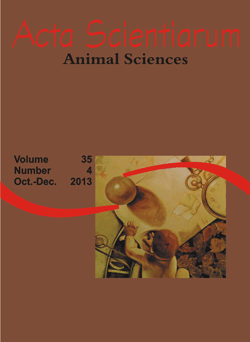<b>Direct and indirect effects of measures and reasons morphometric on the body yield of Nile tilapia, <i>Oreochromis niloticus</i></b> - doi: 10.4025/actascianimsci.v35i4.19807
Abstract
The study was carried out with the objective of verifying which measures and morphometric ratios are more directly related to the body yield of Nile tilapia, Oreochromis niloticus, in two weight classes. Data were analyzed from 257 specimens of tilapia divided into two weight classes: p1 = 400 to 599 g and p2 = 600 to 900 g. The morphometric measurements standard length (SL), head length (HL), body height (BH) and body width (BW), and the ratios of these measures (HL / SL, BH / SL, BW / SL, HL / BH, BW / BH, BW / HL) were evaluated. The following body yields were calculated: carcass (RCAR), fillet (RFILE) and head (RCAB). The data were initially submitted to the "stepwise" procedure to eliminate problems of multicollinearity among the morphometric variables, then the correlations between the dependent variables (body yield) and the independent variables (measured and morphometric relationships) were calculated. Later, these correlations were divided into direct and indirect effects through path analysis, and the direct and indirect contributions of each variable measured in percentage terms. The morphometric ratio BW/HL, for both weight classes, was the variable most highly correlated and with the highest direct effect on RFILE and RCAB, showing to be the most important morphometric variable studied for tilapia carcass trait determination.
Downloads
DECLARATION OF ORIGINALITY AND COPYRIGHTS
- I Declare that current article is original and has not been submitted for publication, in part or in whole, to any other national or international journal.
The copyrights belong exclusively to the authors. Published content is licensed under Creative Commons Attribution 4.0 (CC BY 4.0) guidelines, which allows sharing (copy and distribution of the material in any medium or format) and adaptation (remix, transform, and build upon the material) for any purpose, even commercially, under the terms of attribution.
Read this link for further information on how to use CC BY 4.0 properly.








































